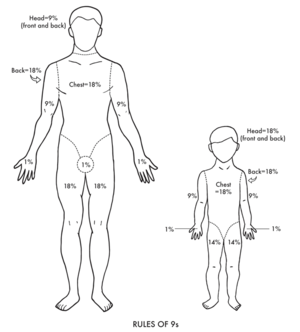Assessment and Immediate Management[edit | edit source]
The principles of initial assessment of patients with burns are the same as all other trauma patients and start with the Primary Survey, following the ABCDE approach.
There are specific considerations during resuscitation of a patient with burns:
Airway: Specific Considerations in Patients With Burns[edit | edit source]
Burns to the airway are suggested by hoarseness, stridor (laryngeal oedema) facial and mouth burns, burning of nasal hair, soot in nostrils or on palate.
These burns may lead to swelling and airway compromise.
Give Oxygen!
Consider early endotracheal intubation before airway compromise worsens.
Breathing: Specific Considerations in Patients With Burns[edit | edit source]
Wheeze, or evidence of increased work of breathing.
Beware circumferential, full-thickness burns of chest or neck which may impair breathing.
Note: Clinical manifestations of inhalation injury may not appear for the first 24 hours.
Circulation: Specific Considerations in Patients With Burns[edit | edit source]
Hypovolaemic shock is a feature of severe burns.
Good IV or Intra Osseous access & appropriate clinically guided fluid replacement are important.
Fluid Resuscitation in Burns Patients - The Parkland Formula[edit | edit source]
Burns covering more than 15% in Adults and 10% in Children require intravenous fluid resuscitation.
The Parkland Formula for burns resuscitation is one easy method to calculate fluid requirements in the first 24hrs.
- Start with: 2-4 ml x kg x % Total Body Surface Area of Burn (partial and full-thickness burns only)
- 50% is given during the first 8 hours (from the time of the burn)
- 50% is given over the next 16 hours
- The goal is to achieve a urinary output of:
- 0.5–1.0 ml/kg/hr in Adults
- 1.0-1.5ml/kg/hr in Children
- Infusion rate is principally determined by urine output
Note: All published fluid formulas are only guidelines. Individual clinical assessment and particularly urine output must guide treatment and more fluid is commonly required.
Disability: Specific Considerations in Patients With Burns[edit | edit source]
Patients may be hypoxic/hypercapnic with confusion.
Early detection of peripheral neurovascular compromise due to circumferential limb and digit burns is essential. Consider early escharotomy or fasciotomy.
Exposure and Environmental Control: Specific Considerations in Patients With Burns[edit | edit source]

Estimate the burn area, including the back, by using the rule of 9s (patient’s palm is 1%).
Patients with burns are at risk of hypothermia due to loss of skin and prolonged exposure during assessment. The burn should be covered, as soon as possible after assessment, with sterile dressings such as plastic cling film.
The source of burn is important e.g. fire, hot water, paraffin, kerosene etc. Electrical burns are often more serious than they appear due to current flowing preferentially through deep tissues. Damaged muscle can result in acute renal failure.
Further Management Considerations[edit | edit source]
Undertake the following:
- Administration of pain relief
- Nasogastric drainage
- Prevention of Hypothermia
- Administration of tetanus prophylaxis
- Do not use early prophylactic antibiotics